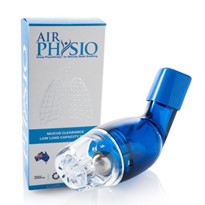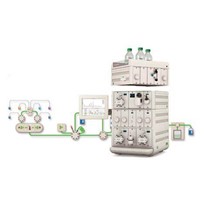Our lungs are amazing organs which not only help us breathe and exchange oxygen (O2) with carbon dioxide (CO2), but are an essential component in helping to balance the acidity and alkalinity levels in our body to keep us at a balance pH level of 7.4.
If the lungs fail to remove excess CO2 from the blood, our blood becomes acidic, causing symptoms, such as fatigue and confusion. Decreased amount of CO2 secondary to, for example, alveolar hyperventilation, causes our arterial blood to become alkalemic, making us feel lightheaded, confused, etc.
How Your Lungs Work to Help Feed Your Body
Our lungs are broken into 2 main sections as follows (shown to the right):
- Conducting Zone (larger airways)
- Respiratory Zone (smaller airways and air sacs)
The conducting zone’s role is to filter and remove foreign particles from the air that we breathe, preventing as many particles and pathogens (bacterium, virus, or other microorganism) as possible from reaching the respiratory zone where the gas exchange occurs between CO2 and O2.
Conducting Zone (larger airways)
The conducting zone has two main methods of filtering and removing particles: The mucociliary escalator and the airway epithelium.
How Does the Mucociliary Escalator Work?
The mucociliary escalator removes larger particles like dust, smoke and bacteria out of the lungs. It produces mucus which acts like a net and sits on top of the cilia. Cilia are hair-like structures that beat back and forth to move the mucus up to the throat like an escalator (hence, mucociliary—mucus and cilia—escalator) to be either swallowed or coughed out naturally.
A good way to picture this is someone crowd surfing at a rock concert. The mucus is the ball shown in the picture and the crowd are the cilia moving the ball along. When everything is going well, the ball moves freely, but if there is an issue, the ball can either fall or get stuck in the crowd and can’t be moved.
So Why is The Mucociliary Escalator Important?
About 90% of inhaled particles, including respiratory viruses, are cleared through the mucociliary escalator. The best way to understand the importance of the mucociliary escalator is to look at the 2 pictures to the right and imagine the mucociliary escalator as a flowing stream and the leaves as inhaled particles. When the water is flowing smoothly (up to 1 cm per minute), the leaves (inhaled particles) float on the surface and are carried downstream smoothly, as shown on the top image, and the water is kept clear and hygienic. When there is a blockage or buildup of water and the water no longer flows smoothly or simply stops, then the leaves sink to the bottom of the water, making it hard to remove and causing the water to become contaminated, clouded and unhygienic.
The Airway Epithelium as Barrier
Just like the clogged-up water, the lungs need to use another method to help clear out the particles. The airways need to use a secondary defense mechanism that involves the airway walls initiating proinflammatory immune responses causing inflammation of the airways. Upon viral recognition, the outer tissue lining of the airway walls, also known as the airway epithelium, releases antiviral proteins into the submucosa (a layer of connective tissue beneath the mucous membrane) which cause inflammation to occur to fight against respiratory viruses.
During viral infection, the epithelium can be injured, and repeated widespread damage to the epithelium may lead to abnormal epithelial repair, loss of cilia, increased mucus production, and airway hyperresponsiveness, as well as viruses leading to bacterial infection. Excessive mucus production causes severe airway obstruction and, along with airway inflammation, leads to ciliary damage and weakening including loss of cilia and interference of ciliary beating.
Respiratory Zone (smaller airways and air sacs)
For foreign particles which make it past the conducting zone, the respiratory zone has its own lines of defense that consists of non-inflammatory and inflammatory white blood cells.
Non-Inflammatory Digestive Cells
During normal breathing, the alveolar (air sacs) lining fluid contains proteins that recognize targets, such as bacteria, viruses, fungus, etc., and alveolar macrophages (white blood cells) that fight the smaller particles and pathogens, as well as larger particles that were not effectively eliminated by the mucociliary escalator. The alveolar macrophages often clear particles and pathogens silently and quickly by noninflammatory phagocytic defense, in which the particles and pathogens (bacteria, virus, etc.) are digested by the white blood cells without inducing inflammation. The alveolar macrophages attach to the particle/pathogen absorb it and then break it down.
Think again of the alveolar macrophage as fish and the water as alveolar fluid. When everything is going well and the food source (particles, bacteria, viruses, mold, etc.) are at a normal level, then the fish can handle this and keep the water (alveolar fluid) clean and hygienic like the picture to the right.
When the water is supplied with too much food and contaminants, then the fish (alveolar macrophages) find it hard to clean up the volume of food and contaminants (particles, bacteria, viruses, mold, etc.), requiring additional assistance for removing those from the water.
Digestion by Inflammatory White Blood Cells
The first line of defense normally works well, but when we get an excess volume of foreign particles or entities like smoke, mining dust, pollution or an assault from bacteria, viruses or mold, then the alveoli need to recruit the second line of defense.
The second line of defense is recruitment by the alveolar macrophages of inflammatory white blood cells, such as neutrophils and eosinophils, from the lung capillaries, to allow for digestion of smaller particles (bacterium, virus, mold, etc.). If incomplete resolution of inflammation occurs in the tissue, it may lead to chronic inflammation and permanent damage to the tissue, causing the walls of the airways to break down, alveoli (air sacs) to become remodeled, and less surface area for gas transfer and exchange. Think of a fish pond that is overcrowded with fish (alveolar macrophages and other white blood cells) where the ecosystem is permanently changed and the overstocked situation causing problems in water quality and changes in the condition of pond bottom soil (i.e. the alveoli fluid changes and walls may become damaged).
How Does the Gas Transfer Occur in the Lungs?
The oxygen (O2) is absorbed through the plasma into the circulatory system to be attached to hemoglobin in the blood stream, while the carbon dioxide (CO2) is released by the hemoglobin through the plasma into the lungs to be breathed out.
The O2 rich blood is then returned to the heart to be distributed to the rest of the body for use in the cells to be used to generate energy (or ATP) in the cells, as well as to help remove excess carbon waste from the cells in the form of CO2.
How Does Lack of Oxygen Affect the Cells?
There are 2 methods of energy production used in the cells based on the amount of oxygen available in the blood. These are Aerobic Respiration (oxygen-rich blood, normal deep breathing) and Anaerobic Respiration (oxygen-lacking blood, shortness of breath, holding breath, etc.).
Aerobic Respiration consists of three steps. (Energy production with Oxygen)
- Glycolysis (2 ATP)
- Krebs Cycle (2 ATP)
- Electron Transport Chain (34 ATP)
Total = 38 ATP
Waste carbon is carried away from the cells in the form of carbon dioxide (CO2). This is normal operations of the cells.
Anaerobic Respiration consists of two steps (Energy production without Oxygen):
- Glycolysis (2 ATP)
- Fermentation/Glycolysis (lactate, known as lactic acid)
Total = 2 ATP
Waste Carbon is unable to be released from the cells due to lack of oxygen to carry away as carbon dioxide (CO2) and fermentation (lactate) happens in the cell which is experienced as burning a muscle sensation, telling us to take a break and breathe deeper.
As you may be able to see, the lack of oxygen can cause the body to produce as little as 1/19th the amount of energy in the cells and produces fermentation in the cells, leading to them becoming acidic and eventually create permanent damage if not treated.
What Happens When You Have Breathing Problems
There are many breathing problems experienced by people and in some cases, these breathing problems go unrecognized or undiagnosed. One study found that up to 43% of people living with Chronic Obstructive Pulmonary Disease (COPD -Emphysema and/or Chronic Bronchitis) do not realize or are not diagnosed with this condition.
The following respiratory conditions may cause breathing problems secondary to problems in the conducting and respiratory zones:
- Asthma,
- Bronchiectasis,
- Bronchitis and Chronic Bronchitis,
- Cystic Fibrosis,
- Emphysema
- Atelectasis
Asthma is a hypersensitivity of the airway walls causing the walls to react to specific triggers, causing three distinct conditions as follows:
- Inflammation of the airways
- Bronchoconstriction (constriction of the muscles around the large airways)
- Mucus hypersecretion (hard to clear mucus)
With the inflammation and bronchoconstriction in asthma, the mucus can be hard to clear and can build up, causing mucociliary dysfunction. This leads to ongoing lung hygiene issues where particles, bacteria, viruses, mold, etc. build up and can’t be cleared (similar to the water with the rotting leaves in it as shown above).
This can lead to ongoing lung function loss of between 5- 25 ml per year (approx. 1 shot glass per year) due to mucus obstruction, mucus plugging, leading to collapse of the alveoli.
Bronchiectasis is a condition where there is damage to the airway walls and/or the cilia which causes a gap in the mucociliary escalator where mucus falls into and can’t be cleared. This leads to ongoing lung hygiene issues where particles, bacteria, viruses, mold, etc. build up and can’t be cleared (similar to the water with the rotting leaves in it as shown above).
Mucus blockage and mucus plugs are a common occurrence in bronchiectasis, to the point that 2 studies found a decline in lung function of between 44-64 ml per year in these patients. This is equivalent to approx. 2 shot glasses of lung function loss per year.
Acute and chronic bronchitis are conditions of the larger airways of the lungs. Acute bronchitis is an infection of the larger airways. This can occur as a secondary infection which starts as a cold or flu (in the nose and throat). Once it enters the bronchial tubes that carry air into the lungs and induces inflammation, it is no longer considered as a cold or flu, but it become classified as bronchitis.
Bronchitis has 2 distinct conditions as follows:
- Inflammation of the airways
- Mucus hypersecretion (hard to clear mucus)
While the inflammation can be treated using medication, the mucus can be hard to clear and can build up causing mucus dysfunction. This leads to ongoing lung hygiene issues where particles, bacteria, viruses, mold, etc. build up and can’t be cleared (similar to the water with the rotting leaves in it as shown above).
While ongoing lung function can vary according to the cause, COPD is known to cause up to 23 ml loss of lung function per year due to mucus obstruction, mucus plugging, leading to collapse of the alveoli (air sacs), while someone who smokes more than 1 packet a day has been reported to lose as much as 33 ml per year (approximately 1 shot glass per year).
Cystic Fibrosis is a hereditary condition which affects the lungs and digestive system because of a malfunction in the exocrine system, responsible for producing saliva, sweat, tears and mucus.
The issue with cystic fibrosis is that the mucus is extremely sticky, making it very hard to move which leads to ongoing issues with mucus clearance. This leads to ongoing lung hygiene issues where particles, bacteria, viruses, mold, etc. build up and can’t be cleared (similar to the water with the rotting leaves in it as shown above).
Emphysema is gradual destruction of lung tissue, leading to alveolar collapse and air trapping, making it difficult to breathe.
Emphysema is caused by 3 main events happening in the lungs as follows:
- Inflammation of the smaller airways
- Inflammation of the alveoli
- Alveolar destruction and air trapping in the alveoli.
This leads to ongoing lung hygiene issues where particles, bacteria, viruses, mold, etc. build up and can’t be cleared (similar to overcrowded with fish as shown above).
While ongoing lung function can vary according to the cause, emphysema caused by smoking more than 1 packet per day has been reported to lose as much as 33 ml per year (approximately 1 shot glass per year) due to mucus obstruction, mucus plugging, leading to collapse of the alveoli (air sacs).
People who are at high risk of emphysema include:
- Smokers,
- People living in areas of high pollution,
- People working in mining areas with high levels of rock dust,
- Asbestos workers,
- People working with paints, fumes, etc.
People who live in very unhygienic environment with particles and toxins constantly bombarding the lungs, causing a constant state of inflammation at the alveolar walls, causing the alveoli to break down and remodel and tubes into the alveoli to become inflamed and narrow, causing the air to be trapped in the alveoli, leading to loss of lung function and potential damage to the lungs.
Atelectasis is a collapsed lung via collapsed alveoli, usually due to mucus plugging or severe swelling and/or inflammation of the smaller airways.
This may be the result of either one of 100,000’s of alveoli, a branch of the smaller airways resulting in numerous alveoli being cut off. Though in very severe cases, there may be loss of one-half or all of one lung if the mucus plug has formed in the large airways.



















